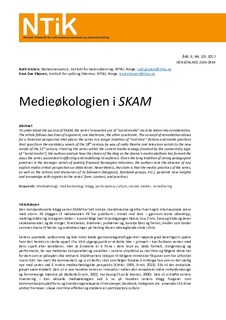| dc.contributor.author | Grüters, Anna Ruth | |
| dc.contributor.author | Eliassen, Knut Ove | |
| dc.date.accessioned | 2018-01-15T15:01:50Z | |
| dc.date.available | 2018-01-15T15:01:50Z | |
| dc.date.created | 2017-11-29T08:10:07Z | |
| dc.date.issued | 2017 | |
| dc.identifier.citation | Nordisk Tidsskrift for informationsvitenskab- og kulturformidling. 2017, 6 (2/3), 60-67. | nb_NO |
| dc.identifier.issn | 2245-2931 | |
| dc.identifier.uri | http://hdl.handle.net/11250/2477641 | |
| dc.description.abstract | To understand the success of SKAM, the series’ innovative use of “social media” must be taken into consideration. The article follows two lines of argument, one diachronic, the other synchronic. The concept of remediation allows for a historical perspective that places the series in a longer tradition of “real time”-fictions and media practices that span from the epistolary novels of the 18th century by way of radio theatre and television serials to the new media of the 21st century. Framing the series within the current media ecology (marked by the connectivity logic of “social media”), the authors analyze how the choice of the blog as the drama’s media platform has formed the ways the series succeeded in affecting and mobilizing its audience. Given the long tradition of strong pedagogical premises in the teenager serials of publicly financed Norwegian television, the authors note the absence of any explicit media critical perspectives or didacticism. Nevertheless, the claim is that the media-practices of the series, as well as the actions and discourses of its followers (blogposts, facebook-groups, etc.), generate new insights and knowledge with regards to the series’ form, content, and practices | nb_NO |
| dc.language.iso | nob | nb_NO |
| dc.publisher | Institut for Informationsstudier, Københavns Universitet | nb_NO |
| dc.rights | Attribution-NonCommercial-NoDerivatives 4.0 Internasjonal | * |
| dc.rights.uri | http://creativecommons.org/licenses/by-nc-nd/4.0/deed.no | * |
| dc.title | Medieøkologien i SKAM | nb_NO |
| dc.type | Journal article | nb_NO |
| dc.type | Peer reviewed | nb_NO |
| dc.description.version | publishedVersion | nb_NO |
| dc.source.pagenumber | 60-67 | nb_NO |
| dc.source.volume | 6 | nb_NO |
| dc.source.journal | Nordisk Tidsskrift for informationsvitenskab- og kulturformidling | nb_NO |
| dc.source.issue | 2/3 | nb_NO |
| dc.identifier.cristin | 1519944 | |
| dc.description.localcode | Copyright (c) 2017 Nordisk Tidsskrift for Informationsvidenskab og Kulturformidling Creative Commons License Dette manuskript er licenseret under en Navngivelse - Ikke-kommerciel - Ingen Bearbejdede Værker (by-nc-nd) international licens. | nb_NO |
| cristin.unitcode | 194,67,80,0 | |
| cristin.unitcode | 194,62,60,0 | |
| cristin.unitname | Institutt for lærerutdanning | |
| cristin.unitname | Institutt for språk og litteratur | |
| cristin.ispublished | true | |
| cristin.fulltext | original | |
| cristin.qualitycode | 1 | |

